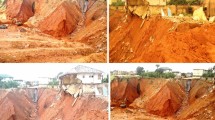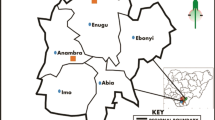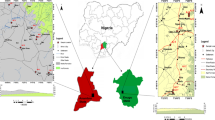Abstract
The geotechnical characteristics of soils that are susceptible to severe gullying in the rain forest zone of Nigeria were studied. The soils are predominantly sands whose fines (silt/clay) contents are very negligible.
The sands are loose (dry density 1.42–1.73 g/cm3) and highly permeable (permeability 9.43×103−3.4×102cm/s) with permeability increasing with depth. Porosities and void ratios are also high (41.6–50.3% and 0.71–1.01 respectively), while cohesion is small to zero (0–85 kN/m2). It is thought that although these conditions favour less runoff and high infiltration, they lead to high internal flow velocities and seepage pressures, and ultimately high internal erosion.
It is concluded that once a gully is initiated, the soil properties become responsible for rapid propagation. Non response of the gullies studied to afforestation control measures is thought to result from these soil properties.
Résumé
Les caractéristiques géotechniques des sols qui sont susceptibles d'être sérieusement ravinés dans les régions forestières du Nigéria ont été étudiées. Ces sols sont essentiellement des sables dont la fraction fine (limon et argile) est négligeable.
Ces sables sont meubles (densité à sec 1,42–1,73 g/cm3) et présentent une perméabilité très importante qui augmente avec la profondeur (perméabilité 9,43×10−3−3,4×10−2cm/s). Les porosités et les indices de vides sont également élevés (respectivement 41,6–50,3% et 0,71–1,01), tandis que la cohésion est très faible à nulle (0–85 kN/m2). Bien que ces conditions soient peu favorables au ruissellement et permettent une infiltration importante, elles entrainent des vitesses d'écoulement interne et des pressions d'infiltration élevées qui conduisent à une forte érosion interne.
Une fois qu'un ravinement est initié, les propriétés du sol sont responsables de sa rapide propagation. Nous pensons que les difficultés de reboisement sur ces sols résultent de leur propriétés particulières.
Similar content being viewed by others
References
BOWLES J.E., 1978: Engineering properties of soils and their measurement 2nd ed. McGraw Hill, New York.
BROWN G.W., 1962: Piping erosion in Colorado. Jour. Soil & Water Conservation, 17: 220–222.
CARMAN P.C., 1937: Fluid flow through a granular bed. Trans. Inst. Chem. Engr., London, 15: 150–156.
EGBOKA, B.C.E. and UMA K.O., 1986: Comparative analysis of Transmissivity and Hydraulic conductivity values from the Ajali Aquifer system of Nigeria. Jour. Hydrol. 83: 185–196.
EZECHI J.I., 1987: An engineering geological study of selected gully sites in Anambra and Imo States, Nigeria. Unpublished M.Sc. thesis, University of Nigeria.
EZECHI J.I. and OKAGBUE C.O.: A genetic classification of gullies in eastern Nigeria and its implications on control measures. Jour. African Earth Sci., in submittal.
HARLEMAN D.R.E., MELHORN P.F. and RUMER R.R., 1963: Dispersion-permeability correlation in porous media. J. Hydraul. Div. Am. Doc. Civ. Eng., 89 (HY2): 67–85.
HAZEN A., 1893: Some physical properties of sands and gravels. Mass. State Board of Health, 24th Annu. Rep.
KOZENY J., 1927: Uber Kapillore Leitung des Wassers im Boden Sitzungsber Akd Wiss Wien, 271–306.
LOGAN J., 1964: Estimating transmissivity from routine production tests of water wells. Groundwater, 2(1): 35–37.
MASANNAT Y.M., 1980: Development of piping erosion conditions in the Benson area, Arizona Quart. Jour. Engr. Geol., 13: 53–61.
MASCH F.D. and DENNY K.J., 1966: Grain size distribution and its effect on the permeability of unconsolidated sands. Water Resour. Res., 2: 665–667.
OKAGBUE C.O., and UMA K.O., 1987: Performance of gully erosion control measures in southeastern Nigeria. Proc. Inter. Symp. Forest Hydrology and watershed management, Vancouver, Canada, IAHS Publ., No. 167, pp. 163–172.
PARKER G.G. and JENNE E.A., 1967. Structural failure of western U.S. highways caused by piping. Highway Research Board, Washington D.C.
Author information
Authors and Affiliations
Rights and permissions
About this article
Cite this article
Okagbue, C.O., Ezechi, J.I. Geotechnical characteristics of soils susceptible to severe gullying in eastern Nigeria. Bulletin of the International Association of Engineering Geology 38, 111–119 (1988). https://doi.org/10.1007/BF02590454
Published:
Issue Date:
DOI: https://doi.org/10.1007/BF02590454




